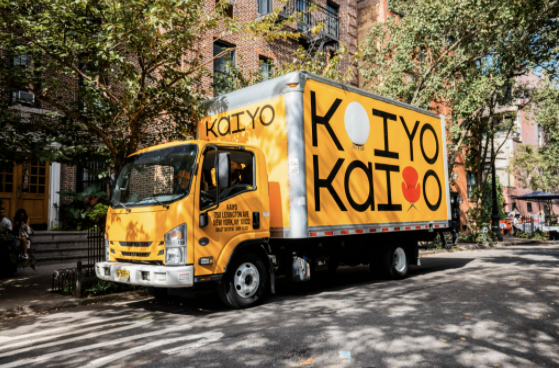Why online furniture platforms like Kaiyo are turning to physical retail

Kaiyo, an online furniture resale marketplace, is trying to sell more couches and chairs offline.
This past weekend, Kaiyo held its first-ever in-person shopping event in New York City at Not-a-Normal Market, a pop-up marketplace for vintage goods and home decor. Kaiyo’s booth included an eclectic, modern mix of brightly colored chairs, lamps, artwork and couches. It sold 30% of what it displayed during the two-day event, and its biggest sale was a $2,000 red Ligne Roset Ploum sofa that can retail for $10,000 when new.
Kaiyo is one of a number of digitally-native furniture platforms making the move to physical retail to appeal to younger shoppers, many of whom are furnishing their first apartments and prefer to buy big-ticket items in person. Wayfair, for instance, opened its first large-format store, a 150,000-square-foot location in Illinois, last month. The company is treating its retail expansion “in a very measured way” and will evaluate how its new store is performing before moving forward with others, Wayfair CEO Niraj Shah said on an earnings call in May.
According to digital consultancy firm CI&T, most furniture buyers (30%) prefer to start their furniture-buying journey at a specialty store. There, they can touch and test out pieces in a way they can’t online, and they can get an idea of how an item might fit into their existing space. What’s more, for those who are interested in secondhand furniture, shopping in person allows them to get a better sense of a piece’s condition, color and texture before purchasing.
Furniture companies got a big boost during the pandemic as people spent more time at home. Some, like Kaiyo, announced expansion plans to new markets. Now, some of these companies are facing slowdowns as shoppers pull back on making large purchases because of inflation. Z Gallerie, Mitchell Gold + Bob Williams and Noble House Home Furnishings all filed for bankruptcy in 2023. Last month, Wayfair reported that its total net revenue for the first quarter was down 1.6% year over year. Having some sort of physical presence is one way for challenged companies to buck this downward trend.
Kaiyo was founded in 2016 as a full-service furniture marketplace that handles everything from pickup to product photography. One of Kaiyo’s biggest selling points is that it has a white-glove delivery service. Kaiyo did not offer delivery for its Not-a-Normal Market event, so it purposefully chose smaller items from its assortment so customers could walk out with their purchases, Grace Baena, director of branded content at Kaiyo, told Modern Retail.
The fact that New Yorkers were willing to buy Kaiyo’s furniture on the spot “speaks to the quality of the pieces and how the assortment aligned with the clientele that was coming in,” Baena said. She estimated that half of the people who came by Kaiyo’s booth had heard of the company, and half had not. One visitor said Kaiyo had picked up a piece of furniture from his house a day earlier.
While Kaiyo sells gently-used furniture, Wayfair sells furniture, home decor, housewares and home improvement products. Melissa Minkow, director of retail strategy at CI&T, visited Wayfair’s new store an hour outside Chicago and was surprised by the vast selection, which included everything from bathroom showers to decorative tiles to Le Creuset cookware.
“The store is a clear answer to Ikea in a lot of ways, in terms of how many different things you can buy there,” she said. “Wayfair’s not just competing with Bob’s Discount Furniture or Pottery Barn. They’re competing with Target. They’re competing with Home Depot.”
The Wayfair store is in a suburban, higher-income neighborhood in a mall where a Bed Bath & Beyond location used to be. “I think where they’re trying to go with this is young families and middle-aged parents shopping for their college kids,” Minkow said. The Wayfair has a café that sells avocado toast and spiked seltzer, perhaps an attempt to woo millennials. Wall displays feature QR codes, and snippets of text explain “how to personalize your wall art.”
Minkow thinks it’s smart that online furniture sellers are going into physical retail. “It feels very risky to buy furniture strictly online without having seen it in person,” she said. “The learned behavior that so many people are doing with bracketing — ordering multiple sizes and returning one — doesn’t translate well to furniture.”
Overall, Kaiyo’s Baena deemed the Not-a-Normal Market pop-up a success. “It ended up being quite seamless,” she said. The market’s founder and organizer Lale Boz told Modern Retail that she and Kaiyo will hold another event together in September.
“We’re really happy with the pieces we sold, the visibility we got and the connections that we were able to make,” Baena said. “We’re excited to have this under our belt and know we’re capable of it and there’s an appetite for it.”
